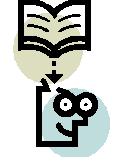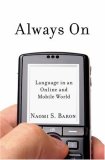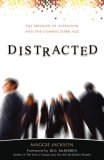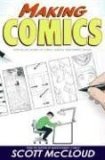reviews elsewhere
June 25, 2008

books on the mind, consciousness, cognitive science…
June 21, 2008
These two recent titles seem to go together to describe my way of life these days. ‘Always On’ is a more scholarly examination by a professor of linguistics of the effects of new communication technologies on language, whereas ‘Distracted’ is a journalistic account of the effects of those technologies on attention.

Always On: Language in an Online and Mobile World by Naomi S. Baron (Oxford University Press, 2008)
Product description:
In Always On, Naomi S. Baron reveals that online and mobile technologies–including instant messaging, cell phones, multitasking, Facebook, blogs, and wikis–are profoundly influencing how we read and write, speak and listen, but not in the ways we might suppose.
Baron draws on a decade of research to provide an eye-opening look at language in an online and mobile world. She reveals for instance that email, IM, and text messaging have had surprisingly little impact on student writing. Electronic media has magnified the laid-back “whatever” attitude toward formal writing that young people everywhere have embraced, but it is not a cause of it. A more troubling trend, according to Baron, is the myriad ways in which we block incoming IMs, camouflage ourselves on Facebook, and use ring tones or caller ID to screen incoming calls on our mobile phones. Our ability to decide who to talk to, she argues, is likely to be among the most lasting influences that information technology has upon the ways we communicate with one another. Moreover, as more and more people are “always on” one technology or another–whether communicating, working, or just surfing the web or playing games–we have to ask what kind of people do we become, as individuals and as family members or friends, if the relationships we form must increasingly compete for our attention with digital media?
Our 300-year-old written culture is on the verge of redefinition, Baron notes. It’s up to us to determine how and when we use language technologies, and to weigh the personal and social benefits–and costs–of being “always on.” This engaging and lucidly-crafted book gives us the tools for taking on these challenges.
Science Daily article on ‘Always On’
Author Naomi S. Baron’s webpage

Distracted: The Erosion of Attention and the Coming Dark Age by Maggie Jackson, with a foreword by Bill McKibben (Prometheus Books, 2008)
Description from the publisher;
We have oceans of information at our fingertips, yet we seek knowledge in Yahoo headlines glimpsed on the run. We are networked as never before, but we connect with friends and family via email and fleeting face-to-face moments that are rescheduled a dozen times.
Welcome to the land of distraction.
Despite our wondrous technologies and scientific advances, we are nurturing a culture of diffusion and detachment. Our attention is scattered among the beeps and pings of a push-button world. We are less and less able to pause, reflect, and deeply connect.
Distracted is a gripping exposé of this hyper-mobile, cyber-centric, attention-deficient life. Day by day, we are eroding our capacity for deep attention — the building block of intimacy, wisdom, and cultural progress. The implications for a healthy society are stark.
And yet we can recover our powers of focus through a renaissance of attention. Neuroscience is just now decoding the workings of attention, with its three pillars of focus, awareness, and judgment, and revealing how these skills can be shaped and taught. This is exciting news for all of us living in an age of overload.
In her sweeping quest to unravel the nature of attention and detail its losses, Maggie Jackson introduces us to scientists, cartographers, marketers, educators, wired teens, and even roboticists. She offers us a compelling wake-up call, an adventure story, and reasons for hope.
Pull over, hit the pause button, and prepare for an eye-opening journey. More than ever, we cannot afford to let distraction become the marker of our time.
June 15, 2008
 Mind Hacks had a recent post (“Consciousness happens between the panels“) discussing Scott McCloud’s Understanding Comics: The Invisible Art (1993). I’m also a fan of McCloud’s work, and I’ve just recently been browsing through his Making Comics: Storytelling Secrets of Comics, Manga and Graphic Novels (2006), which has a wonderful section on emotions and facial expressions. He has another book, Reinventing Comics: How Imagination and Technology Are Revolutionizing an Art Form, (2000) that I haven’t seen.
Mind Hacks had a recent post (“Consciousness happens between the panels“) discussing Scott McCloud’s Understanding Comics: The Invisible Art (1993). I’m also a fan of McCloud’s work, and I’ve just recently been browsing through his Making Comics: Storytelling Secrets of Comics, Manga and Graphic Novels (2006), which has a wonderful section on emotions and facial expressions. He has another book, Reinventing Comics: How Imagination and Technology Are Revolutionizing an Art Form, (2000) that I haven’t seen. 

Amazon also has Scott McCloud’s 10 American Comics to Read
See also Scott McCloud’s website and Wikipedia article
June 13, 2008
(On supposed memory boosters):
“Eating a dozen almonds may just be my generation’s version of Pascal’s wager.”
–Sue Halpern, Can’t Remember What I Forgot: The Good News from the Front Lines of Memory Research, p. 7
June 7, 2008
“How the Mind Works: Revelations” by Israel Rosenfield and Edward Ziff (New York Review of Books, v. 55, n. 11, June 26, 2008) surveys some recent works on neuroscience by Jean-Pierre Changeux, Gerald Edelman, and Giacomo Rizzolatti.
Books discussed in the article (Amazon links added):
The Physiology of Truth: Neuroscience and Human Knowledge (Mind/Brain/Behavior Initiative) by Jean-Pierre Changeux, tr. by M.B. DeBevoise (Belknap Press, 2004) [“Search Inside the Book” available at Amazon]
Nicotinic Acetylcholine Receptors: From Molecular Biology to Cognition by Jean-Pierre Changeux and Stuart J. Edelstein (Odile Jacob, 2005) [“Search Inside” available at Amazon]
Conversations on Mind, Matter, and Mathematics by Jean-Pierre Changeux and Alain Connes, tr. by M.B. DeBevoise (Princeton University Press, 1995; paperback ed., 1998) [“Search Inside” available]
What Makes Us Think? A Neuroscientist and a Philosopher Argue about Ethics, Human Nature, and the Brain by Jean-Pierre Changeux and Paul Ricoeur, tr. by M.B. DeBevoise (Princeton University Press, 2000; paperback ed., 2002) [“Search Inside” available]
Phantoms in the Brain: Probing the Mysteries of the Human Mind by V.S. Ramachandran and Sandra Blakeslee (HarperCollins Quill paperback ed., 1999) [“Search Inside” available]
Mirrors in the brain: How our minds share actions, emotions, and experience by Giacomo Rizzolatti and Corrado Sinigaglia, tr. by Frances Anderson (Oxford University Press, 2008) [“Search Inside” available]
A Universe Of Consciousness How Matter Becomes Imagination by Gerald Edelman and Giulio Tononi (Basic Books, 2001) [“Search Inside” available]
